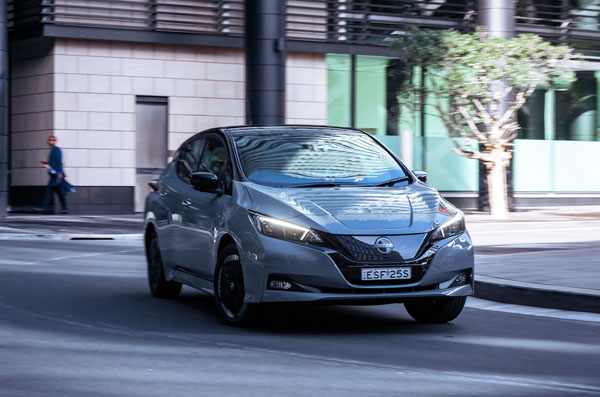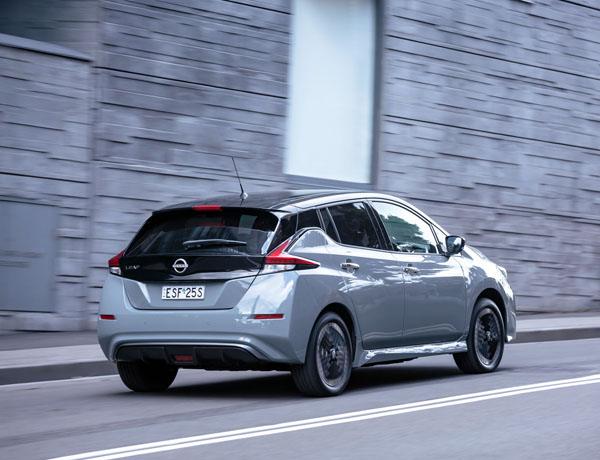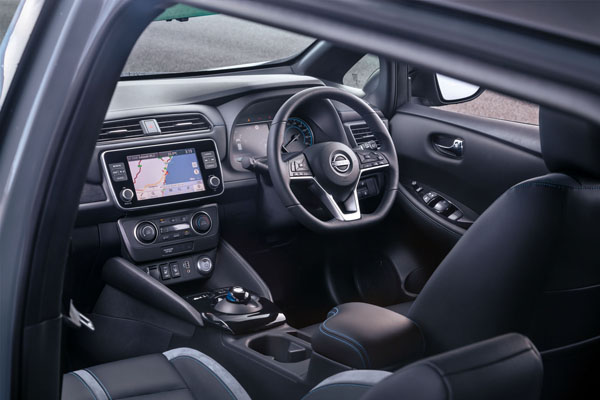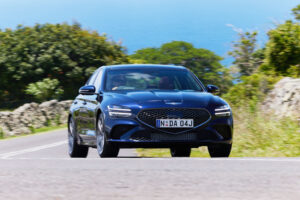
Although it’s no longer a major player in the electric vehicle scene, Nissan Leaf holds an
important role in automotive history, being the first mass-production vehicle of its type
when it was launched worldwide back in 2010.
Over the next decade more than 500,000 Leafs were sold, mostly in Europe, making it one
of the most popular EVs ever.
When it arrived here in 2012 Leaf had the EV market cornered although that steadily
changed with vehicles such as the Mitsubishi i-MiEV, Tesla Model 3 and BMW i3 joining
within a few years. Now, in 2023, almost every car brand has either a full or plug-in EV in
its range.
With many of these competitors offering extra equipment and increased driving range Leaf
sales steadily declined. To meet this challenge the second-generation Leaf was released
here 2019 with the option of a more powerful and longer-range version called the Leaf e+
Gen-two Leaf was given a mid-life upgrade in mid-2022 with some exterior styling changes
and key technology updates. Our review this week is on the extended range Leaf e+.
STYLING
The profile of the Leaf hasn’t changed significantly during its decade on the road. It comes
with the same semi-coupe / SUV body that many of its competitors have adopted. Its lines
are clean and simple with a sloping roofline, flowing headlights and blacked-out B and C
pillars.
Changes for MY23 include new badging, revised front faux grille, darkened headlight
trims, new rear diffuser and spoiler.

Likely to be most noticeable change are a new design for the 17-inch alloy wheels which
seem to polarise opinions. We love them, but others that have seen them immediately
cringe.
A big plus from our experience is that the charging point is at the front of the car making it
much easier to connect than most of its rivals who have them on the rear/side of the body.
Apart from the closed front in place of a traditional grille the only exterior clues to Leaf
being an EV are ‘zero emission’ badges on the sides and rear and the blue and white
diamond on the number plates.
INTERIOR
At around $60,000 plus on-roads Nissan Leaf sits at the more affordable level of EV
pricing and it shows with a relatively bland interior when compared with the spectacular
presentation of newer, but more expensive, cars like the Ioniq 5 and Kia EV6.
There is no powered seat option and height-only steering wheel adjustment.
Having said that the dashboard is neat and functional with most controls logically placed
and easy to reach.
One of our pet hates are functions that are need constant tapping on small keys on the
touchscreen. By contrast Leaf uses four large round knobs – two for audio volume /
channel change on the sides of the screen and two below for air conditioning temperature
/ fan speed. So much more sensible with much less driver distraction.

One new feature for the 2023 upgrade is the intelligent rearview mirror which doubles as a
standard mirror but with a flick of a control becomes a built-in LCD monitor which displays
images from a camera mounted on the rear of the vehicle for an unobstructed view.
Rear seat space is acceptable with enough leg and headroom for two taller occupants. A
third adult in the centre would be wedged between the other two, made worse with a tall
transmission tunnel on the floor.
There’s no folding armrest in the rear, nor air vents or USB ports.
Boot space is a pretty good 405 litres although the two charging cables and Bose audio
located there. The loading lip is high with quite a big drop down to the cargo floor. The
60/40 split rear seatbacks can be folded down to extend storage to 1776 litres.
There’s no powered tailgate and the spare wheel is a space-saver which is bolted under
the rear of the car.
POWERTRAIN
The Leaf e+ is powered by a 59-kWh lithium-ion battery that generates maximum power
and torque outputs of 160 kW and 340 Nm. Courtesy of the instant torque that is a feature
of all hybrids of EVs it can get to 100km/h in just 6.9 seconds.
There are two charging sockets located under a small hatch at the front of the bonnet that
can be unlocked either from a switch in the dashboard or a button on the key fob.
Charging times for the e+ vary from 90 minutes from a 56kW DC fast charger, through
11.5 hours with a 6.6kW AC charger. Anyone who pays the high premium for an EV, will
more than likely fork out the extra couple of grand to have the latter installed at their home
and/or office. If not, they’ll be stuck with a full-charge time of 32 hours from a standard
domestic AC outlet.
Charging times for the 39-kWh battery in the standard Leaf are 60 minutes, 7.5 hours and
21 hours respectively.
Both Leaf variants come with bi-directional charging capability, commonly known as V2L
(Vehicle to Load), a technology that allows energy from the car’s battery to be used to
power external appliances.
SAFETY
Standard safety features in both Leaf variants include front and rear parking sensors ,
forward collision warning, intelligent emergency braking with pedestrian detection, lane
departure warning, around view monitor, adaptive cruise control, rear cross-traffic alert,
driver inattention alert, traffic sign recognition, high beam assist and blind spot warning.
The two outer rear seats get Isofix child seat anchors.
New in the MY23 Leaf is Canto. Because EVs make no engine noise this can cause
problems for pedestrians and other road users. Activated at speeds up to 30km/h, Canto
emits an artificial sound that varies in pitch depending on whether the vehicle is
accelerating, slowing or reversing.
INFOTAINMENT
There are two screens, an 8.0-inch touchscreen for the NissanConnect infotainment
system in the centre of the dash and a 7.0-inch Driver-Assist instrument cluster display
behind the steering wheel.
Infotainment features in both variants include embedded satellite navigation (including the
location of the nearest public charging stations), Apple CarPlay and AndroidAuto, DAB+
digital radio, are available.
There is a single USB port located directly above a deep opening that’s perfectly sized for
storage of a smartphone.
Both models get a Bose 7-speaker energy efficient premium audio system.
DRIVING
Composed is the perfect description of the Leaf’s performance. To match the improved
output of the electric motor and converter, engineers enhanced the car’s chassis to
improve stability.
The electric power steering is responsive with a nice linear feel.
Noise, vibration and harshness have been moderated with aerodynamic upgrades and
structural rigidity, while the electric motor has been made quieter, despite generating more
power and torque.
Leaf has what is called an e-Pedal, which at the flick of a switch on the centre console,
allows the vehicle to be driven using the accelerator alone. The car comes to a smooth,
gradual halt and is held stationary without the use of the brake pedal.
Unfortunately, on the Leaf the e-Pedal is either on or off unlike many competitors where
the level of braking can be adjusted to suit conditions. We found that, in motorway
conditions, the extra pressure needed to maintain traffic speed negated the benefit of the
e-Pedal and we tended to use it only on downhill running.
Out on the open road ride and handling proved to be excellent and the torque pick up will
appeal to keen drivers. The absence of any engine sound combined with good external
noise suppression and much less range anxiety adds further to the driving enjoyment.
Nissan lists a 385-kilometre range for the Leaf e+ although it showed up as 427 km when
we picked up our test vehicle. During the week we did a couple of 3-hour top-up charges
with our Wallbox home charger. In total we covered 352 kilometres and still showed a
range of just over 200 km when we returned the car. So that projected 385 km range
seems to be quite achievable.
There is tyre noise on rough road surfaces. But why wouldn’t there be with little or no
sound from under the bonnet?
SUMMING UP
The enhancements added to the MY23 Leaf come at price with an increase of $1000 over
the previous models taking the e+ to $61,490 and $50,990 for the standard 39 kWh Leaf
at. On-road costs need to be added.
Premium purchase prices and refuelling convenience continue to be major hurdles for
electric vehicles. But for those wishing to give it a go, the Nissan Leaf is as good as any
petrol-powered close rival.
AT A GLANCE
MODEL RANGE
Nissan LEAF: $50,990
Nissan LEAF e+: $61,490
Note: These prices do not include government or dealer delivery charges. Contact your
local Nissan dealer for drive-away prices.
SPECIFICATIONS (Nissan Leaf 59-kWh lithium-ion 350V battery, five-door wagon)
POWERTRAIN
Capacity: 62kWh
Configuration: Lithium-ion battery, AC synchronous motor, reduction drive
Maximum Power: 160 kW
Maximum Torque: 340 Nm
Fuel type: Electric
Driving range: 385 km
CO2 emissions: zero g / km
DRIVELINE:
Drivetrain: Reduction drive, shift by wire, 2WD
DIMENSIONS, WEIGHT AND CAPACITIES:
Length: 4490 mm
Width: 2030 mm including mirrors
Height: 1540 mm
Wheelbase: 2700 mm
Kerb weight: 1594 kg
BRAKES:
Front: Ventilated Disc
Rear: Ventilated Disc
STANDARD WARRANTY:
Five years / unlimited kilometres. Eight years on the battery.











